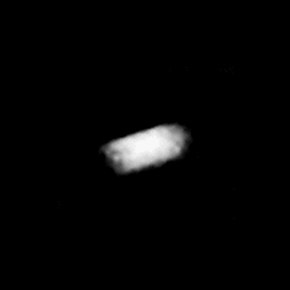


| |
| Discovery | |
|---|---|
| Discovered by | Stephen P. Synnott[1] and Voyager Imaging Team |
| Discovery date | July 1989 |
| Designations | |
Designation | Neptune VI |
| Pronunciation | /ɡæləˈtiːə/[2] |
Named after | Γαλάτεια Galateia |
| Adjectives | Galatean[3] |
| Orbital characteristics[4][5] | |
| Epoch 18 August 1989 | |
| 61952.57 km | |
| Eccentricity | 0.00022 ± 0.00008 |
| 0.42874431 ± 0.00000001 d | |
| Inclination |
|
| Satellite of | Neptune |
| Group | ring shepherd |
| Physical characteristics | |
| Dimensions | (204±10) × (184±16) × (144±8) km[6] |
| 88±4 km[6] | |
| Volume | ~2.8×106 km3[a] |
| Mass | 1.94×1018 kg[8] |
Mean density | ~0.69 g/cm3[b] |
| ~0.012–0.025 m/s2[c] | |
| ~0.05–0.06 km/s[d] | |
| synchronous | |
| zero | |
| Albedo | 0.08[6][9] |
| Temperature | ~51 K mean (estimate) |
| 21.9[9] | |
Galatea /ɡæləˈtiːə/, also known as Neptune VI, is the fourth-closest inner moonofNeptune. It is named after Galatea, one of the fifty NereidsofGreek legend, with whom Cyclops Polyphemus was vainly in love.

Galatea was discovered in late July 1989 from the images taken by the Voyager 2 probe. It was given the temporary designation S/1989 N 4.[10] The discovery was announced (IAUC 4824) on 2 August 1989, and mentions "10 frames taken over 5 days", implying a discovery date of sometime before July 28. The name was given on 16 September 1991.[11]
Galatea is irregularly shaped and shows no sign of any geological modification. It is likely that it is a rubble pile re-accreted from fragments of Neptune's original satellites, which were smashed up by perturbations from Triton soon after that moon's capture into a very eccentric initial orbit.[12]
Galatea's orbit lies below Neptune's synchronous orbit radius, so it is slowly spiralling inward due to tidal deceleration and may eventually impact the planet or break up into a new planetary ring system upon passing its Roche limit due to tidal stretching.
Galatea appears to be a shepherd moon for the Adams ring that is 1,000 kilometres (620 mi) outside its orbit. Resonances with Galatea in the ratio 42:43 are also considered the most likely mechanism for confining the unique ring arcs that exist in this ring.[13] Galatea's mass has been estimated based on the radial perturbations it induces on the ring.[14][7]




Since Galatea is irregularly shaped, the actual surface gravity and escape velocity will vary significantly between different positions on the surface.
|
| |||||||
|---|---|---|---|---|---|---|---|
Listed in approximately increasing distance from Neptune | |||||||
| Regular (inner) |
| ||||||
| Irregular |
| ||||||
| See also |
| ||||||
| |||||||
|
Natural satellites of the Solar System
| ||
|---|---|---|
| Planetary satellitesof |
| |
| Dwarf planet satellitesof |
| |
| Minor-planet moons |
| |
| Ranked by size |
| |
| ||
|
| |||||||
|---|---|---|---|---|---|---|---|
| |||||||
| Geography |
| ||||||
| Moons |
| ||||||
| Astronomy |
| ||||||
| Exploration |
| ||||||
| Related |
| ||||||
| |||||||